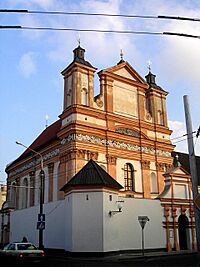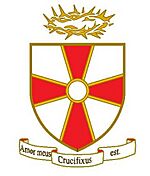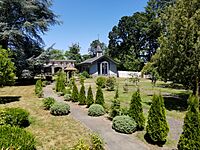Bridgettines facts for kids

The Bridgettines are a Christian religious group within the Catholic Church. They are also known as the Order of the Most Holy Savior. Saint Birgitta (Bridget of Sweden) started this order in 1344. It was officially approved by Pope Urban V in 1370. The Bridgettines follow the rules of Saint Augustine. Today, there are a few different groups of Bridgettines.
Contents
A Look Back in Time
The very first monastery for the Bridgettine order was built in 1369. It was located at a former royal castle in Vadstena, Sweden. The order quickly grew in Sweden and Norway. It helped a lot with spreading culture and books in these areas. Because of this, the main monastery in Vadstena stayed open until 1595. This was even after the Protestant Reformation had changed many things in Scandinavia.
By 1515, there were 27 Bridgettine houses. Many of these were in Scandinavia. Soon, Bridgettine houses spread to other countries. They eventually reached a total of 80 houses.
In England, a Bridgettine monastery called Syon Abbey was founded in 1415. King Henry V helped to start it. It became a very rich and important religious place. But then, King Henry VIII closed many monasteries. This was part of the Dissolution of the Monasteries. One of the monks from Syon Abbey, Richard Reynolds, was killed. He refused to accept the King as the head of the church. He is now considered a saint.
Syon Abbey was one of the few religious houses that reopened later. This happened during Queen Mary I's time (1553–1558). But when Queen Elizabeth I became queen, the Bridgettine group had to leave England. They traveled to different places. Finally, in 1594, they settled in Lisbon, Portugal. They stayed there for a long time. In 1861, they were able to return to England.
Syon Abbey in Devon was special. It was the only English religious group that had continued without stopping since before the Reformation. Many of the Bridgettine monasteries in Northern Europe were destroyed during the Reformation.
Bridgettine Groups Today
As of 2013, there were about 800 Bridgettine members. The sisters wear a special veil. It has a crown called the "Crown of the Five Holy Wounds." This crown has five red marks. These marks remind them of the Five Wounds Christ received on the Cross. The monks wear a red cross on their cloak. This cross has an image of a Eucharistic host in the middle.
Most Bridgettine houses earn money by offering bed and breakfast to guests.
Original Medieval Group
The first Bridgettine group, from medieval times, still has four independent monasteries:
- Maria Refugie Abbey in Uden, Netherlands
- Syon Abbey in Isleworth, England (closed in 2011)
- Birgittakloster in Altomünster Germany (closed in 2017)
- Pax Mariae Abbey in Vadstena, Sweden
Spanish Group
Marina de Escobar started a Spanish group in the 1630s. This group is only for nuns. They follow a slightly changed version of St. Bridget's Rule. Today, this group has four monasteries in Spain. It also has four in Mexico and one in Venezuela.
Swedish Group
The largest Bridgettine group today was started by Saint Elizabeth Hesselblad. She was a nurse. She founded this group on September 8, 1911. These sisters focus on helping people who need a place to rest. The Holy See (the Pope's main office) fully approved this group in 1940. Now, they have convents in Europe, Asia, and North America.
The main house for this group is in Rome, Italy. It is in the same building where Saint Birgitta once lived. This convent also offers rooms for guests. The sisters also welcome people from other Christian faiths. They have ecumenical outreach as part of their mission.
UK Group
Iver Heath in Buckinghamshire was the first place for the new Bridgettine group in the UK. It has been a place for prayer and hospitality since 1931. In 1999, Bridgettine sisters moved into a new convent. This was at the Maryvale Institute in Birmingham.
St. Bridget's Rules
The first Bridgettine Order was for both men and women. They focused on devotion to the Passion of Jesus Christ. It was a "double order." This means each monastery had a small group of monks. These monks acted as chaplains (priests who help with religious services). But the abbess (the head nun) was in charge of everyone.
St. Bridget's rules said that there should be no more than sixty nuns. There were also four lay sisters (nuns who did not take full vows). For the men, there were thirteen priests. There were also four deacons (who could also be priests). And there were eight lay brothers. These brothers helped with daily tasks.
The nuns stayed inside the monastery. They focused on learning and studying. The monks, however, also traveled to preach and spread their faith. Each monastery was under the local bishop. And, to honor the Virgin Mary, an abbess always led them.
Bridgettine Monks
There is a special group of Bridgettine monks in Amity, Oregon, in the US. Their monastery is called Our Lady of Consolation. It was started in 1976. This is the only Bridgettine monastery for men in the world today. The monks here usually do not become priests. This follows the original way of monasticism. This monastery supports itself by selling delicious chocolate fudges and truffles.
Anglican Bridgettines
The Most Holy Saviour Fraternity is an Anglican group. It was founded in Mexico on September 14, 2012. The bishop of the Anglican Diocese of the West, Mexico approved it in 2013.
See also
- Katerina Lemmel
- Mother Tekla Famiglietti
- Societas Sanctae Birgittae
- Pirita convent






